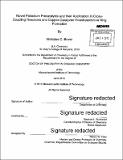Novel palladium precatalysts and their application in cross- coupling reactions and copper-catalyzed enantioselective ring formation
Author(s)
Bruno, Nicholas C. (Nicholas Charles)
DownloadFull printable version (49.19Mb)
Other Contributors
Massachusetts Institute of Technology. Department of Chemistry.
Advisor
Stephen L. Buchwald.
Terms of use
Metadata
Show full item recordAbstract
Chapters 1 - 3. A series of easily prepared, phosphine-ligated palladium precatalysts based on the 2-aminobiphenyl scaffold have been prepared. The role of the precatalyst-associated labile halide (or pseudohalide) in the formation and stability of the palladacycle has been examined. It was found that replacing the chloride in the previous version of the precatalyst with a mesylate leads to a new class of precatalysts with improved solution stability and that are readily prepared from a wider range of phosphine ligands, including the bulky, electron-rich di-tert-butylphosphino biaryl ligands. Additionally, N-methyl- and N-phenyl analogues have been prepared. These efficacy of these precatalysts were examined in a broad range of C-C, C-N, and C-O bond-forming reactions. Chapter 4. The intramolecular hydroalkylation of di- and trisubstituted alkenes bearing a pendant alkyl bromide to form stereodefined (hetero)carbocycles is reported. The system is highly regio- and stereoselective and employs a Cu-DTBM-SEGPHOS catalyst and (dimethoxy)methylsilane as the stoichiometric reductant. This intramolecular hydroalkylation reaction provides facile access to a multitude of ring systems and its utility is further demonstrated in the enantioselective synthesis of paroxetine.
Description
Thesis: Ph. D. in Organic Chemistry, Massachusetts Institute of Technology, Department of Chemistry, 2015. Cataloged from PDF version of thesis. Includes bibliographical references.
Date issued
2015Department
Massachusetts Institute of Technology. Department of ChemistryPublisher
Massachusetts Institute of Technology
Keywords
Chemistry.